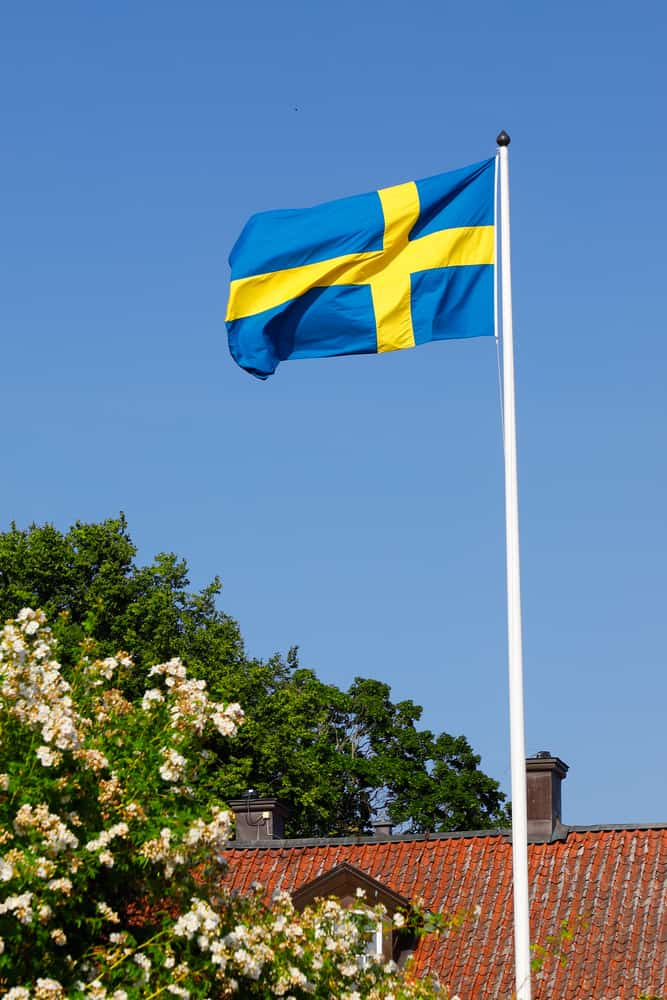The distinctive blue and yellow of the flag of Sweden definitely stands out in a crowd, especially for a country that regularly bats above its average in anything from music to sport.
But what’s the Swedish flag’s meaning, really? Why does it have a cross and do the blue and yellow colors mean anything?
Keep reading to find out everything there is to know about one of the key symbols representing Sweden!

Table of Contents
What’s the meaning of the Swedish flag?
The blue background of the Swedish flag represents what the country and the people of Sweden stand for. These attributes include the belief in standing up for truth and justice, being loyal, persevering, and being vigilant in all things. This is highlighted by a golden yellow cross.
The cross, in turn, is representative of the people of Sweden and their generosity to others (which is definitely one of the typical traits of Swedish people!).
The history of the Swedish flag is long and interesting, but not a lot is known about the origins of its design. It is thought, among historians, that the flag was inspired by Denmark’s flag. The exact age of the Swedish flag is also a mystery.
The meaning of the Swedish flag serves to identify the nation as a whole with its dual message using two distinctive colors.
Related: Swedish Traditional Clothing: The Ultimate Guide
Why does Sweden’s flag have a cross?
History notes that the Swedish flag is modeled after the red and white cross flag of Denmark, known as the Dannebrog. The flag is similar in design to that of the Swedish flag, with both containing what has become known as the Nordic cross.
Legend has it that the Danish flag fell from the sky during a battle in the 12th century. The battle took place during the crusades, and at the time, many flags displayed a cross motif.
The golden cross set against the blue background of the Swedish flag is considered to be representative of Christianity.

How old is the Swedish flag?
Back in the 14th century, Sweden, along with Norway and Denmark, entered into a union of the royal houses, known as the Kalmar Union. The flags for these three countries were reportedly based on the red-and-white design of the Danish flag.
Historical records note that the first legal description of Sweden’s flag was mentioned in a royal warrant dated April 19, 1562. At that time, King Gustav I was the ruler of the country.
When did Sweden change its flag?
Sweden changed its flag on June 22, 1906 to what remains the current national flag. This followed the dissolving of the union between Sweden and Norway in 1905. Despite this date, Swedes actually celebrate flag day on June 6.
The Nordic countries, which also include Iceland and Finland as well as Sweden, Norway, and Denmark, have all carried the same design for many years. When these countries gained independence, each chose a new design.
Finland gained its independence in 1917, Iceland in 1915, and Norway initially declared its independence on May 17, 1814, but was officially proclaimed in 1905.

Why is Sweden’s flag blue and yellow?
The light blue and golden yellow colors of the Swedish flag are representative of the nation’s coat of arms. Information from the Nordic Flag Society notes the Swedish flag and its colors were confirmed in the mid-16th century. The general consensus is that the colors and design combine features of Sweden’s two coats of arms.
There is the national coat of arms and also the Greater Coat of Arms of the Kingdom of Sweden. Displayed on the coat of arms are two shields highlighted in a light blue color. Within each shield, there is a set of three golden crowns placed in a circle in the center of the shield.
The two colors of light blue and golden yellow have remained the same on the Swedish flag since its inception in the 16th century,
Does Sweden have a war flag?
Sweden has two flags, the national version and a military version. While both have the same colors, the national flag is in the shape of a rectangle, whereas the military flag, instead of being a complete rectangle, has a three-tailed or pronged design on one end.
